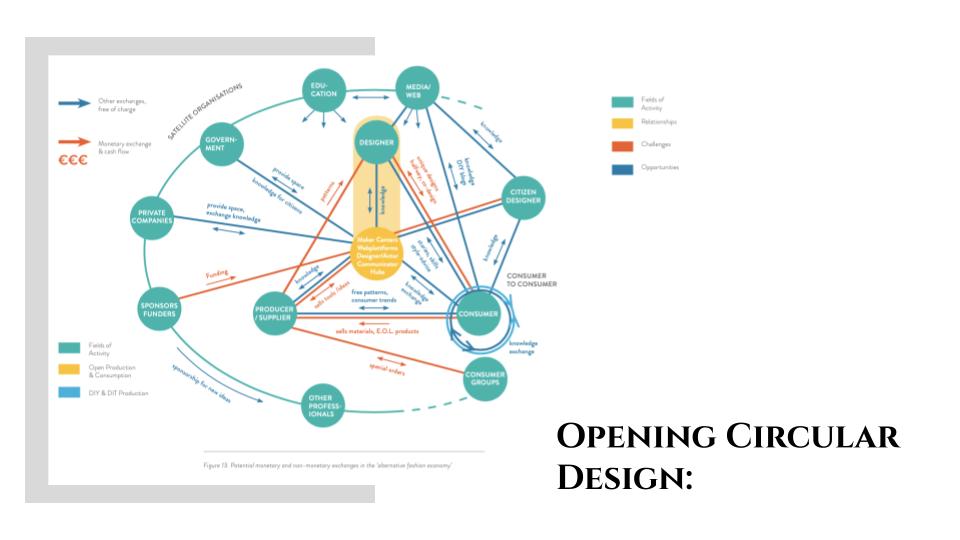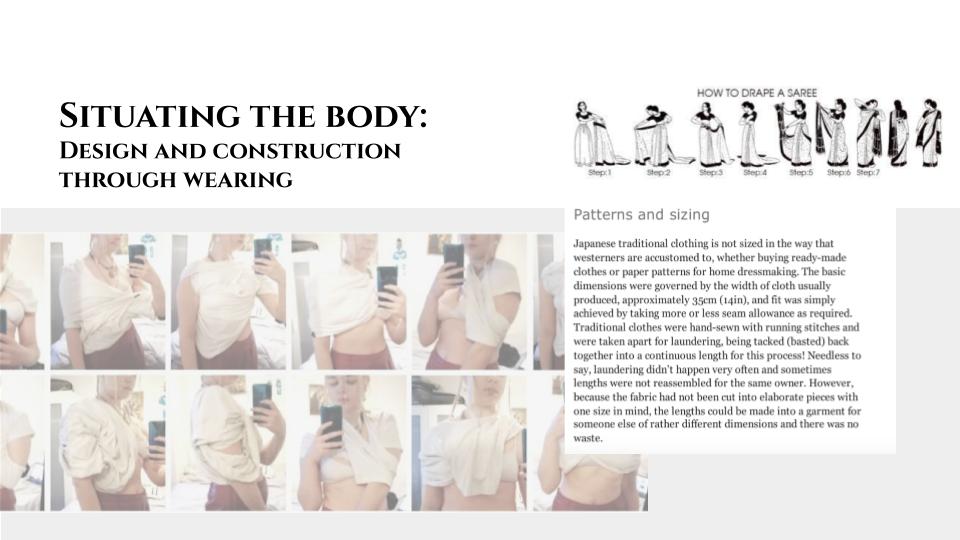13. Implications and Applications¶
Research¶
weekly assignment
Check out the weekly assignment here or login to your NuEval progress and evaluation page.
get inspired!
https://oscircularfashion.com/project/-MTW973hKikcopir3L28 https://class.textile-academy.org/2024/viviane-labelle/assignments/week03/ https://class.textile-academy.org/2023/anna-cain/final%20project/ (silkworm project) https://class.textile-academy.org/2022/surzhana-radnaeva/Final%20project%20TRACES/ (paper garments)
Implications and Applications Notes
Initial Ideas¶
To start this week, I did a quite mindmap to reflect on the weeks that had interested me most from the last term and what topics I had been left wanting to explore more from these. The four weeks I focused on were Open Source Circular Fashion, Computational Couture, Soft Robotics and Open Source Hardware. I am not sure to what extent, if any these will all feature in my final project but I wanted to consider them again in the context of my personal interests and previous practice.

After this, I started trying to map any vague ideas I had about what the project could be. While this ended uo being quite a few different, distinct ideas, there was definately some recurring themes and overlaps between them. I found that from this, the main topic that all the ideas fed back to most was design for disassembly.

During the global session, we had a go at the first round of the Loopholes Game to help develop out project. This was really helpful in making my consider what the benefits of my project would be and who it was aimed at helping.

After I talked through these ideas with Petra, I had a clearer idea of what I wanted to explore even if I still wasn't very clear on what the outcome of the project might be. From this, I planned out my pitch preposal by the main topics as follows:
| Overview | - project name - sentence explaination - |
| Circularity definitions and context | - where we are now - limitations of recycling - breaking black box design - |
| Zero waste pattern making | - difference between traditional - textile led - |
| 3D formed textiles | - garment led textile design - textile manipulations - 3D weaving - |
| Design for disassembly | - problems when used in fashion |
| Situating the body | - construction / design through wear - chronicling wear - mending |
| Open source design | - simplifying pattern language - 2D vs 3D sharing - pattern adaptability - digital design - |
Pitch Proposal Presentation¶
Slide Notes and References¶

Focuses mainly on post consumer as point of reuse
Complicated and expensive to recycle textiles, most can’t be recycled
Continues the Black Box model of fashion and alienation of consumers from their garments
Requires no change to design processes
More points of interaction and re-creation required
- Top: https://www.ellenmacarthurfoundation.org/topics/circular-economy-introduction/overview
- Bottom: https://wornagain.co.uk/about-us/#story

Engages all actors throughout the design and production process
Opens new points of collaboration and knowledge exchange
Links the separate design processes involved in garment creation
- Image: https://www.researchgate.net/publication/304354159_Open_Participatory_Designing_for_an_Alternative_Fashion_Economy

Textile led garment design - from pattern making to suit a sketch to constructing to suit the textile
Minimal cutting requires new ways of shaping and a different approach to textile manipulations
- Left: https://hollymcquillan.com/portfolio/twinset/
- Right Small: https://www.redressdesignaward.com/academy/resources/guide/zero-waste
- Right Small PDF Version: https://static1.squarespace.com/static/582d0d16440243165eb756db/t/5dc98b07736e6578f3c73364/1573489422952/LEARN_Zerowaste_ENG_Nov2019.pdf
- Back: https://lizhaywood.com.au/making-a-zero-waste-pattern/

Constructing textiles in their final 3d form as zero waste - 3d weaving, printing, knitting/crochet traditionally
Explore open source / hacked machines to aid unconventional construction
How to keep them open for change
3D constructions
- Top: https://precariousdesign.files.wordpress.com/2023/02/preprint_conformal__seamless__sustainable-.pdf
- Middle: https://precariousdesign.files.wordpress.com/2023/09/230917_methods_for_designing_woven_textile-forms_updated_final-3.pdf
- Bottom: https://ei.elisava.net/es/layers/

Really considering the end of use in the design process
Can a textile be returned to it initial state after use?
Example not about fashion specifically but some points still relevant
Prioritise more easily damaged components
Easily manipulatable subassemblies
Hierarchically dependent connections
- Image: https://media.freitag.ch/en/fabric/button
- Text: https://www.google.es/books/edition/Design_for_Environmental_Sustainability/Qv-cmRMEwG0C?hl=en&gbpv=1&pg=PA3&printsec=frontcover

Needs limited selection of materials and no fusings
Limit the number of joints and trims
Use larger pattern pieces and material groupings
Modularity allows for selective disassembly
Jacket deconstruction, lots of parts and fusings, change to only blind hems to remove fusing and some construction changes get it down to 1.5 minute deconstruction
- Text: https://www.emerald.com/insight/content/doi/10.1108/01445150710827069/full/html
- Image: https://www.researchgate.net/publication/233627271_Application_of_design_for_disassembly_in_men's_jacket_A_study_on_sustainable_apparel_design
- Video: https://resortecs.com/technology/

Using the act of getting dressed as a new point of creation and co-design
Using the body and specific movements as designer not just object designed around
Openness of garment without physical changes to the textile
Construction/design through wear
- Top: https://blog.g3fashion.com/fashion/9-different-saree-drape-styles-for-occasions/
- Text https://books.google.es/books?hl=en&lr=&id=1EwmEAAAQBAJ&oi=fnd&pg=PT8&dq=kimono+pattern+history&ots=MKRCWz-UFH&sig=3-fw8g1Zpcylo8QoNyUwY9pH3d8&redir_esc=y#v=onepage&q=kimono%20pattern%20history&f=false
- Bottom: From a previous project of mine

Mending as a main pillar of DfD, explore building in to initial product or using mending as a starting point for the product
Visible mending as a way to focus on or collect some data about the use of the garments and position wear and tear as new means for redesign
E-darning machine and potential for open-source hardware style mending machine to limit resources needed to alter
- Top: https://class.textile-academy.org/2022/surzhana-radnaeva/Final%20project%20TRACES/
- Bottom Left: https://dl.acm.org/doi/10.1145/3430524.3444700
- Bottom Right: https://books.google.es/books?hl=en&lr=&id=wRiUEAAAQBAJ&oi=fnd&pg=PT7&dq=textile+mending&ots=474TFI51Xx&sig=4jXmBzl9f9N7SyqbYcKOknigUa4&redir_esc=y#v=onepage&q=textile%20mending&f=false

Knowledge sharing between designer, maker and user means different relations, less distinction
Digital vs physical sharing, files vs garment
2D vs 3D sharing
- Left: https://issuu.com/openwear/docs/openwear_brandmanual
- Right Top: https://makersunite.eu/
- Right Bottom: https://www.are.na/block/1888753

Make pattern usage and garment construction simple to understand and globally sharable
Workshops or virtual tutorials so that this doesn't have to compromise the garment complexity
Potential for parametric alterations when simplified enough
Simplifying pattern language
Pattern adaptability
- Top: From a previous project of mine
- Bottom: https://precariousdesign.files.wordpress.com/2018/02/rffp_a_1400320.pdf

Ease of sharing / changing / toiling
Ease of engagement without pattern knowledge through drape
Pattern adaptability
- Video: https://www.youtube.com/watch?v=Ti_a0cNoavE&embeds_widget_referrer=https%3A%2F%2Fdocs.google.com%2Fpresentation%2Fd%2F184n37ehDZBi1gQC6alxoncqU0dlmpzjBenYP06gq4TU%2Fedit&embeds_referring_euri=https%3A%2F%2Fdocs.google.com%2F&embeds_referring_origin=https%3A%2F%2Fdocs.google.com&source_ve_path=OTY3MTQ&feature=emb_imp_woyt&themeRefresh=1
Pitch Feedback¶
| Oscar | Have you look at the projects from Holly? https://hollymcquillan.com/category/sustainable-design-practice/zero-waste/ Look at the unmaking of the garment? Critical unmaking as an activist practice to challenge circularity principles https://apracticeforeverydaylife.com/projects/duro-olowu-making-unmaking/ - https://www.pinterest.co.uk/jayneemerson/unmaking-no-rules-textile-society/ |
| Cecilia | I like the thoughts you highlighted, I wonder if you can explore beyond "leave no trace" - if we think of nature, often the mechanisms that are embedded into a cycle leave a positive print at the end of their cycle. I would focus on the creation of 1 product, garmnet or outfit, explore reconfigurable as a process on itself |
| Anastasia | I think you have already a lot of great research on the oscircular fashion week, and you can also get inspired by holly mc quillan's work. ii am not sure about the 3d knitting. maybe because you do not have easy access to a knitting machine. i see your collection as a manifesto. also, to make a full collection that can participate in shows, you need 7 pieces. even though there is https://3dprint.com/142948/disney-research-3d-knitting/ project for knitting and also you can have a look at the documentation of Stephanie from Brussels |
| Nuria | I Love your project. It would be incredible to involve young people so they can also be aware of how to combine parts made from clothing that is no longer in use. I recommend to take a look into Aliona's project. |
| Rico | Wow...what an intelligent perspective on the issue of Textile Circularity. Love the statement 'start with the textile...and decide what pattern can be made on it'...to result in zero waste. Please take a look at how a Kimono is cut and constructed...you might find it interesting. Recycling is a losing battle...if the volume of waste being generated is constantly growing...as recycling capacity cannot keep up. |
| Diane | Super interesting to design for disassembly! Who would disassemble? The end-user? Would the clothes come with instructions for that? Zero-waste design : you probably already know the Zero-Waste Design Collective, maybe you're already a part of the community? But in case not: https://www.zwdcollective.org/ |
| Valentine | https://resortecs.com/ |
| Stéphanie | https://vormplatvorm.com/ + https://www.instagram.com/kyo.bags/ |
| Marion | It reminds me of the accessories you can make without seams. |
| Hala | I think its interesting to see how the zero-waste pattern making would come out, in my opinion most of these garments end up having the same language, so would be cool to see if you can use it as a positive instead of as a limitation. I think there are a few paths this could take, maybe after first prototyping, you could stick to one that you find the most interesting to work with! Could it be worth an experiment to do a mini workshop with people who have no fashion or pattern making background to try to make something with a specific amount of textile? (Just because of the concept that when you know less, there are less limits!) |
| ChungHan | Open source fashion is one of the interesting ideas that I discoverd at Fabricademy, will be awesome to see how you play with pattern and structure, alwasy admire how you take a look at wasted fabrics and textile! |
| Stephanie J | Brilliant idea! Very inclusive. I'm confident you will execute this expertly, Excited to see! |